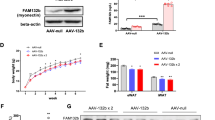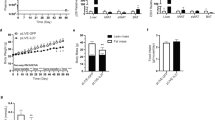Abstract
Adiponectin and its receptors are inversely related to the degree of obesity and have been identified as potential therapeutic targets for the treatment of obesity. In this study, we evaluated the effect of hydrodynamic delivery of adiponectin and/or its receptor 2 (adipoR2) genes on controlling the development of obesity and insulin resistance in AKR/J mice fed a high-fat diet. An increase in adiponectin and adipoR2 gene expression by hydrodynamic gene delivery prevented diet-induced weight gain, reduced fat accumulation in liver and adipose tissue, and improved insulin sensitivity. Beneficial effects were seen with reduced gluconeogenesis in the liver and lipogenesis in the liver, white adipose tissue and skeletal muscle. Real-time PCR analysis demonstrated overexpression of adiponectin and adipoR2 significantly suppressed transcription of phosphoenolpyruvate carboxykinase (pepck), glucose-6-phosphatase (g6pase), stearoyl CoA desaturase 1 (scd-1) and fatty acid synthase (fas) gene. Inhibition effects were mediated by activating the AMP-activated protein kinase (AMPK). These results prove that elevation of adiponectin and/or adipoR2 expression via gene transfer is an effective approach in managing obesity epidemics.
This is a preview of subscription content, access via your institution
Access options
Subscribe to this journal
Receive 12 print issues and online access
$259.00 per year
only $21.58 per issue
Buy this article
- Purchase on Springer Link
- Instant access to full article PDF
Prices may be subject to local taxes which are calculated during checkout






Similar content being viewed by others
References
Scherer PE, Williams S, Fogliano M, Baldini G, Lodish HF . A novel serum-protein similar to C1q, produced exclusively in adipocytes. J Biol Chem 1995; 270: 26746–26749.
Hu E, Liang P, Spiegelman BM . AdipoQ is a novel adipose-specific gene dysregulated in obesity. J Biol Chem 1996; 271: 10697–10703.
Maeda K, Okubo K, Shimomura I, Funahashi T, Matsuzawa Y, Matsubara K et al. cDNA cloning and expression of a novel adipose specific collagen-like factor, apM1 (Adipose most abundant gene transcript 1). Biochem Biophys Res Commun 1996; 221: 286–289.
Nakano Y, Tobe T, ChoiMiura NH, Mazda T, Tomita M . Isolation and characterization of GBP28, a novel gelatin-binding protein purified from human plasma. J Biochem 1996; 120: 803–812.
Arita Y, Kihara S, Ouchi N, Takahashi M, Maeda K, Miyagawa J et al. Paradoxical decrease of an adipose-specific protein, adiponectin, in obesity. Biochem Biophys Res Commun 1999; 257: 79–83.
Capeau J . The story of adiponectin and its receptors AdipoR1 and R2: to follow. J Hepatol 2007; 47: 736–738.
Kadowaki T, Yamauchi T, Kubota N, Hara K, Ueki K, Tobe K . Adiponectin and adiponectin receptors in insulin resistance, diabetes, and the metabolic syndrome. J Clin Invest 2006; 116: 1784–1792.
Kershawand EE, Flier JS . Adipose tissue as an endocrine organ. J Clin Endocr Metab 2004; 89: 2548–2556.
Diezand JJ, Iglesias P . The role of the novel adipocyte-derived hormone adiponectin in human disease. Eur J Endocrinol 2003; 148: 293–300.
Statnick MA, Beavers LS, Conner LJ, Corominola H, Johnson D, Hammond CD et al. Decreased expression of apM1 in omental and subcutaneous adipose tissue of humans with type 2 diabetes. Int J Exp Diabetes Res 2000; 1: 81–88.
Arner P . The adipocyte in insulin resistance: key molecules and the impact of the thiazolidinediones. Trends Endocrinol Metab 2003; 14: 137–145.
Hotta K, Funahashi T, Bodkin NL, Ortmeyer HK, Arita Y, Hansen BC et al. Circulating concentrations of the adipocyte protein adiponectin are decreased in parallel with reduced insulin sensitivity during the progression to type 2 diabetes in rhesus monkeys. Diabetes 2001; 50: 1126–1133.
Yamauchi T, Kamon J, Waki H, Terauchi Y, Kubota N, Hara K et al. The fat-derived hormone adiponectin reverses insulin resistance associated with both lipoatrophy and obesity. Nat Med 2001; 7: 941–946.
Weyer C, Funahashi T, Tanaka S, Hotta K, Matsuzawa Y, Pratley RE et al. Hypoadiponectinemia in obesity and type 2 diabetes: close association with insulin resistance and hyperinsulinemia. J Clin Endocrinol Metab 2001; 86: 1930–1935.
Tsuchida A, Yamauchi T, Ito Y, Hada Y, Maki T, Takekawa S et al. Insulin/Foxo1 pathway regulates expression levels of adiponectin receptors and adiponectin sensitivity. J Biol Chem 2004; 279: 30817–30822.
Peng YH, Rideout D, Rakita S, Sajan M, Farese R, You M et al. Downregulation of adiponectin/adipor2 is associated with steatohepatitis in obese mice. J Gastrointest Surg 2009; 13: 2043–2049.
Yamauchi T, Nio Y, Maki T, Kobayashi M, Takazawa T, Iwabu M et al. Targeted disruption of AdipoR1 and AdipoR2 causes abrogation of adiponectin binding and metabolic actions. Nat Med 2007; 13: 332–339.
Hardie DG . The AMP-activated protein kinase pathway—new players upstream and downstream. J Cell Sci 2004; 117: 5479–5487.
Liu F, Song YK, Liu D . Hydrodynamics-based transfection in animals by systemic administration of plasmid DNA. Gene Therapy 1999; 6: 1258–1266.
Zhang GF, Budker V, Wolff JA . High levels of foreign gene expression in hepatocytes after tail vein injections of naked plasmid DNA. Hum Gene Ther 1999; 10: 1735–1737.
Suda T, Liu D . Hydrodynamic gene delivery: Its principles and applications. Mol Ther 2007; 15: 2063–2069.
Suda T, Suda K, Liu D . Computer-assisted hydrodynamic gene delivery. Mol Ther 2008; 16: 1098–1104.
Kamimura K, Suda T, Xu W, Zhang GS, Liu D . Image-guided, lobe-specific hydrodynamic gene delivery to swine liver. Mol Ther 2009; 17: 491–499.
Kamimura K, Zhang GS, Liu D . Image-guided, Intravascular hydrodynamic gene delivery to skeletal muscle in pigs. Mol Ther 2010; 18: 93–100.
Shklyaev S, Aslanidi G, Tennant M, Prima V, Kohlbrenner E, Kroutov V et al. Sustained peripheral expression of transgene adiponectin offsets the development of diet-induced obesity in rats. Proc Natl Acad Sci USA 2003; 100: 14217–14222.
Park JH, Lee M, Kim SW . Non-viral adiponectin gene therapy into obese 2 type diabetic mice ameliorates insulin resistance. J Control Release 2006; 114: 118–125.
Dzamkoand NL, Steinberg GR . AMPK-dependent hormonal regulation of whole-body energy metabolism. Acta Physiol 2009; 196: 115–127.
Koo SH, Flechner L, Qi L, Zhang XM, Screaton RA, Jeffries S et al. The CREB coactivator TORC2 is a key regulator of fasting glucose metabolism. Nature 2005; 437: 1109–1114.
Combs TP, Pajvani UB, Berg AH, Lin Y, Jelicks LA, Laplante M et al. A transgenic mouse with a deletion in the collagenous domain of adiponectin displays elevated circulating adiponectin and improved insulin sensitivity. Endocrinology 2004; 145: 367–383.
Iwabu M, Yamauchi T, Okada-Iwabu M, Sato K, Nakagawa T, Funata M et al. Adiponectin and AdipoR1 regulate PGC-1alpha and mitochondria by Ca2+ and AMPK/SIRT1. Nature 2010; 464: 1313–1319.
Acknowledgements
This work was supported in part by the National Institute of Health (RO1EB007357 and RO1HL098295). The authors would like to thank Ms Ryan Fugett for proofreading the manuscript.
Author information
Authors and Affiliations
Corresponding author
Ethics declarations
Competing interests
The authors declare no conflict of interest.
Rights and permissions
About this article
Cite this article
Ma, Y., Liu, D. Hydrodynamic delivery of adiponectin and adiponectin receptor 2 gene blocks high-fat diet-induced obesity and insulin resistance. Gene Ther 20, 846–852 (2013). https://doi.org/10.1038/gt.2013.8
Received:
Revised:
Accepted:
Published:
Issue Date:
DOI: https://doi.org/10.1038/gt.2013.8
Keywords
This article is cited by
-
Adiponectin deficiency induces hepatic steatosis during pregnancy and gestational diabetes in mice
Diabetologia (2022)
-
TRPC5 ion channel permeation promotes weight gain in hypercholesterolaemic mice
Scientific Reports (2019)
-
Muscle-specific overexpression of AdipoR1 or AdipoR2 gives rise to common and discrete local effects whilst AdipoR2 promotes additional systemic effects
Scientific Reports (2017)
-
Preventing High Fat Diet-induced Obesity and Improving Insulin Sensitivity through Neuregulin 4 Gene Transfer
Scientific Reports (2016)
-
N-acetylcysteine Protects Mice from High Fat Diet-induced Metabolic Disorders
Pharmaceutical Research (2016)



